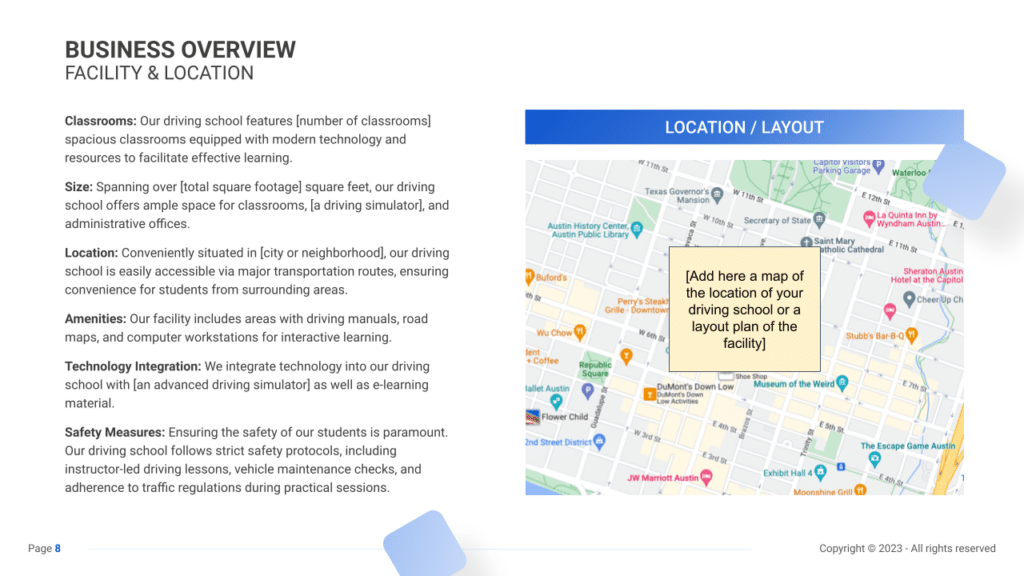How to Write a Business Overview (+ Examples)

Crafting a compelling business overview is a pivotal step in developing a robust business plan. This section not only introduces your business to potential investors, clients, and partners. It also lays the foundation for understanding your company’s business model, target audience and the unique value proposition it brings to the market.
In this comprehensive guide, we’ll guide you through the essentials of writing an effective business overview, accompanied by 2 practical examples taken from real business plans.
Whether you’re an entrepreneur drafting your first business plan or a seasoned business owner, drafting a clear and concise business overview is crucial for articulating your business to investors and lenders. Let’s dive in!
What is a Business Overview?
A business overview in a business plan is a section that provides a concise description of the fundamental aspects of the business.
It serves as an introduction to the business, offering readers a clear understanding of what the business does, its mission, vision, and the market needs it intends to satisfy.
The business section is crucial for setting the context for the detailed plan that follows, giving stakeholders (including potential investors, partners, and employees) a snapshot of the business’s purpose, business model and products and/or services.
What to Include in a Business Overview
The key elements to include are:
- Business Name: The legal name of the business
- Location: its physical location(s), meaning its headquarters and office(s) and/or store(s).
- Business Structure: The legal structure of the business (e.g., sole proprietorship, partnership, corporation, LLC).
- History: A brief history of the business, including its founding, milestones achieved, and any significant changes or developments.
- Products or Services: A description of the products or services offered by the business, highlighting what makes them unique or valuable to customers.
- Target Market: An overview of the business’s primary customers – who they are and what needs or problems the business aims to solve for them.
- Business Model: An outline of how the business plans to make money, detailing its revenue streams, pricing strategy, sales and distribution channels, and any major partnerships or customer segments.
How to write a Business Overview: 4 Steps
Writing a compelling business overview and operations section is a crucial element of a business plan. It provides readers, including potential investors and partners, with a clear picture of what your business is, what it does, and how it operates on a day-to-day basis. Here’s a structured approach to writing these sections:
1. Start with an Introduction
Begin your business overview section by introducing the name of your business, its location, and the type of business structure (e.g., LLC, corporation, partnership). Provide a brief history that includes the founding story, milestones achieved so far, and the current stage of the business.
Key Components
* optional: only if you are preparing a business plan for an existing business
- Business name and location
- Type of business entity
- Brief history and current stage*
2. Define Your Business Concept
Explain your business concept clearly and concisely. What is the core product or service you offer? Who is it for, and what needs does it address? Highlight what makes your offering unique and how it stands out in the market.
Key Components
- Description of products or services
- Target audience
- Unique selling proposition (USP)
3. Detail Your Business Model
Clearly articulate how your business intends to make money. This includes your revenue streams, pricing strategy, sales and distribution channels, and any key partnerships that support your business model.
Key Components
- Revenue model
- Pricing strategy
4. Describe Your Operations
Moving into the operations part of your business plan, provide a detailed account of how your business runs daily. This should include your location(s), facilities, equipment, and the technology you use. Explain your production processes or how your service is delivered, your supply chain, and any logistics involved.
Key Components
- Physical location(s) and facilities
- Production process or service delivery method
- Supply chain and logistics
- Inventory management
- Any proprietary technology or processes
Business Overview: 2 Examples
Here are 2 examples you can use as an inspiration to create yours. These are taken from our coffee shop and driving school business plan templates.
Coffee Shop Business Overview


Driving School Business Overview





